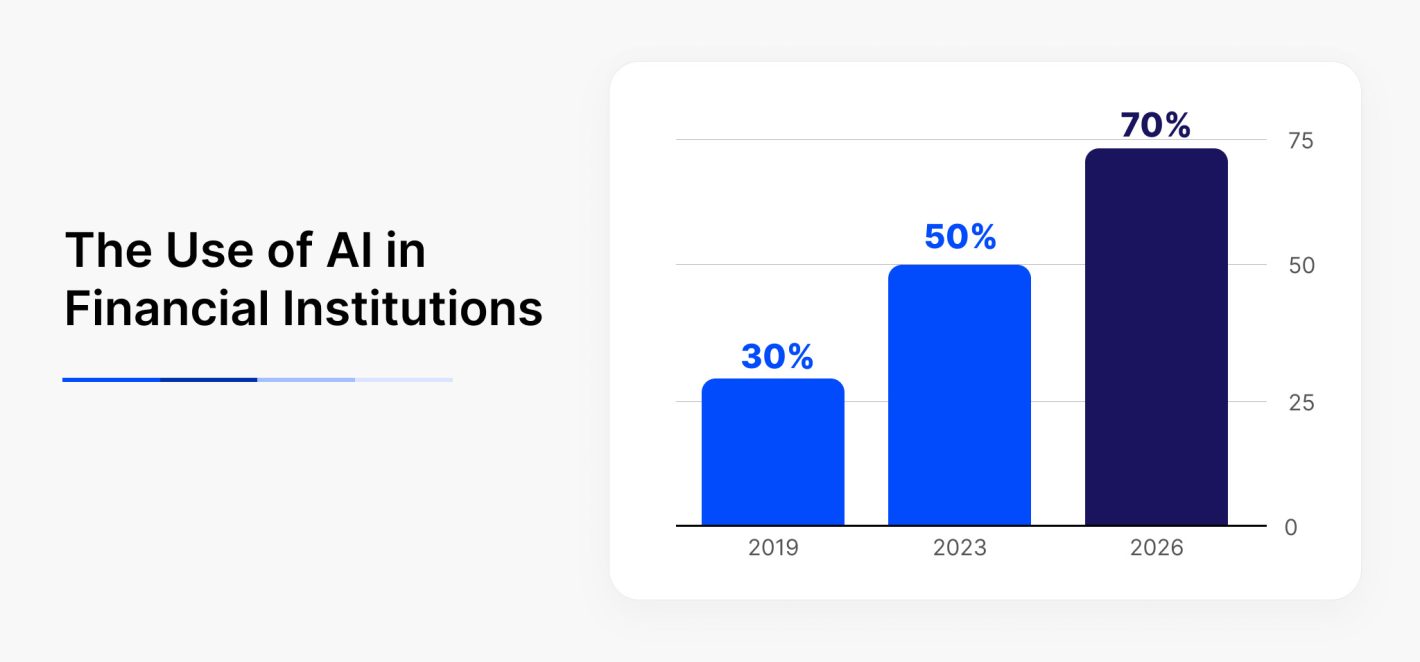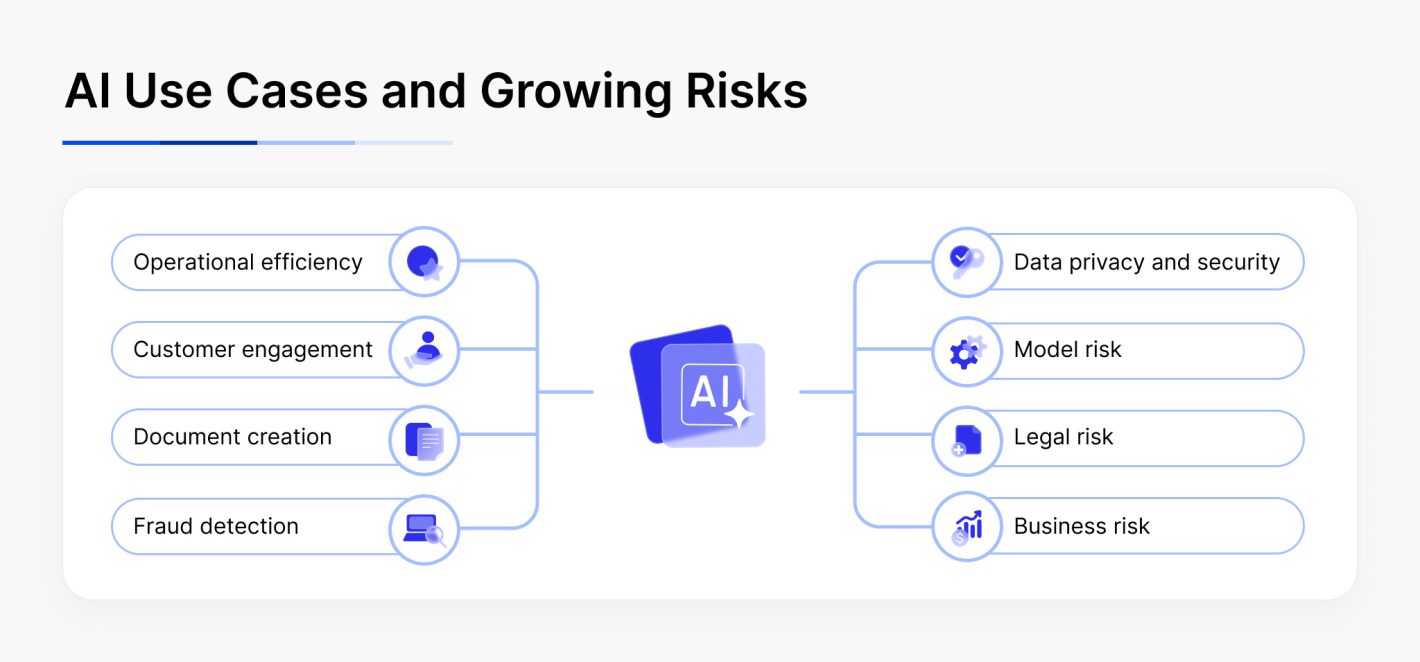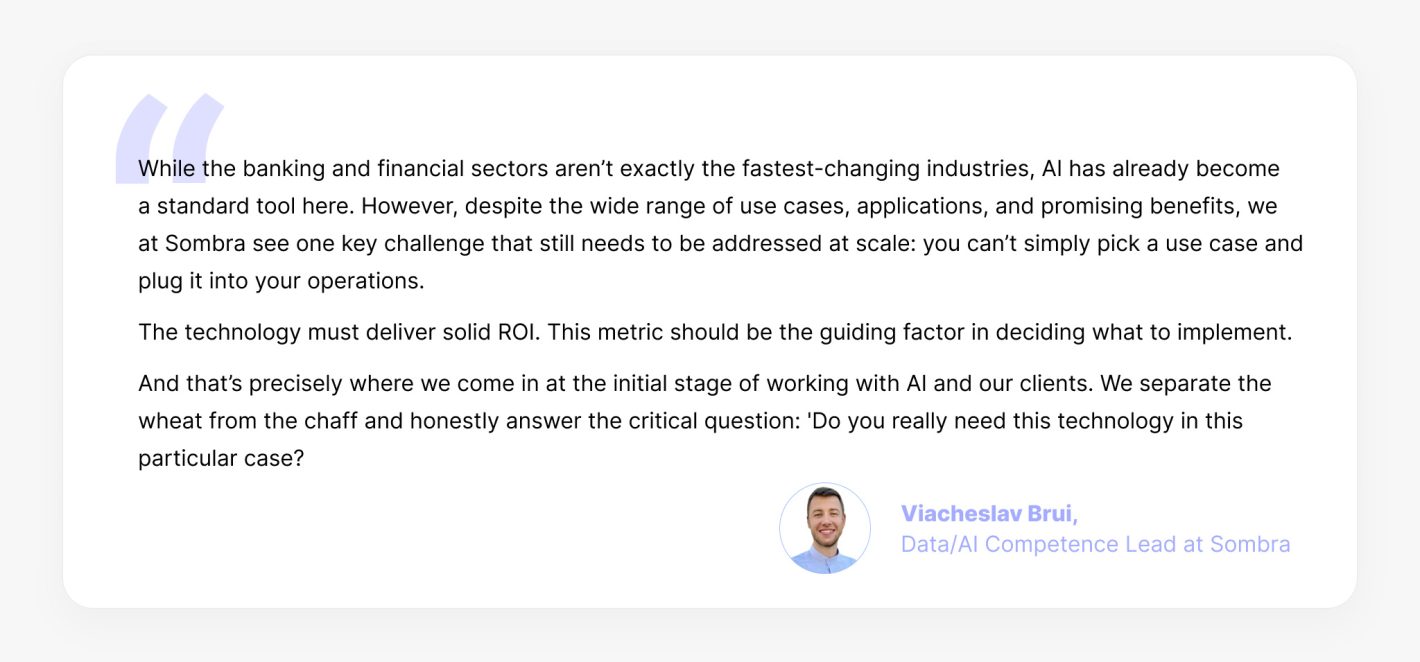As you know, the only constant in the world is Change. Thus, if you happen to open this material in 2027 or later, some things may have become as standard as cloud solutions from AWS. But for now we’ve compiled a practical guide to help you make the most of the ongoing data boom and the growing influence of Artificial Intelligence.

Source: OSFI
Do you need to know these use cases? At Sombra, we think the answer is a resounding yes. From automation to enhanced analytics, AI in financial services has quickly moved from innovation to necessity. Take Canada, for example — a recent study conducted by the Office of the Superintendent of Financial Institutions predicts that over 70% of financial institutions will integrate AI into their operations by 2026. AI is here with its impact falling into four major clusters:



Source: OSFI
- Operational Efficiency: By introducing artificial intelligence in financial services processes, organizations can automate repetitive tasks like post-trade reporting, cutting operational overhead and reducing human error.
- Revenue Generation: AI-driven market analysis uncovers new revenue streams by turning market data into actionable insights.
- Risk Management: Predictive analytics models flag credit risks and detect fraud in real-time, minimizing financial exposure.
- Regulatory Compliance: AI in finance industry streamlines compliance by processing massive volumes of regulatory documentation, reducing reporting time and the risk of violations.
To keep this straightforward, we won’t overwhelm you with endless paragraphs. Instead, we’ve laid it all out on cards. Each card dives into a single use case, explaining its mechanics, offering a clear description, and showing how it can make a difference in the financial services industry. So, let’s start.
Pre- and Post-Trade Automation
Pre-trade and post-trade processes traditionally involve manual steps like validating orders, matching trades, and preparing compliance reports. These tasks often require substantial back-office resources, leading to inefficiencies and operational bottlenecks.
AI-driven automation systems use Natural Language Processing (NLP) and rule-based algorithms to standardize trade data, verify order details, and ensure compliance with financial regulations. NLP tools can extract information from trade confirmations and automatically populate regulatory forms, reducing manual effort.
What does this mean for your organization?



- Reduced back-office workload: Automating validation and reconciliation tasks allows your team to focus on more strategic, high-value activities.
- Improved reporting accuracy: By minimizing human error in compliance submissions and audit trails, your reports become more reliable and precise.
However, AI in financial services is not a plug-and-play solution. Many financial firms rely on legacy infrastructure that wasn’t built to accommodate AI-driven automation. Data inconsistencies, regulatory complexities, and system interoperability issues can cause headaches. Plus, AI still needs oversight to ensure compliance with ever-changing financial regulations.
Example. J.P. Morgan’s COiN Platform
J.P. Morgan implemented an AI system called COiN (Contract Intelligence), which uses NLP to analyze legal documents and extract critical data. Part of the platform’s tasks involves automating post-trade processing, including validating agreements, reconciling trade data, and ensuring compliance. By reducing manual processing time and improving accuracy in data analytics for financial services, COiN has reduced the time required to review 12,000 annual commercial credit agreements from 360,000 hours to just seconds.
Fraud Detection: Identifying Irregular Patterns in Transactions
Fraudulent activity is a relentless threat to financial institutions, draining millions annually through unauthorized transactions and cyber-attacks. Traditional rule-based systems often struggle to adapt to evolving fraud tactics.
AI fraud detection systems are a different story. They use pattern recognition models trained on historical transaction data to identify unusual activity in real time. For instance, they may identify irregular behaviors using decision trees, examine various decision paths with a technique called Random Forests for improved accuracy, or forecast the probability of fraud based on historical behavior. But there is another side to this story. Due to relying on historical data, artificial intelligence in insurance and finance sectors might not catch brand-new fraud tactics in real-time. Plus, overzealous fraud detection can block legitimate transactions, frustrating customers and increasing churn rates.
Even with some cons, the impact is undeniable. Statistics show that 74% of U.S. banks already rely on AI for fraud detection, a clear testament to its effectiveness in combating financial crime.
What does this mean for your organization?



- Reduced Fraud Losses: Real-time risk flagging prevents unauthorized transactions before they are completed.
- Fewer False Positives: Machine learning algorithms continuously adapt to new transaction patterns, reducing incorrect alerts.
Example. PayPal
PayPal has integrated AI to enhance its fraud detection mechanisms. By leveraging AI, PayPal has been able to reduce fraud rates to 0.32% of revenue, showcasing the effectiveness of artificial intelligence insurance industry tools in combating financial crimes and unauthorized activities.
Liquidity Forecasting and Execution Quality Improvement
Balancing liquidity is crucial for companies; they must maintain sufficient cash or easily liquidated assets to fulfill obligations while avoiding unnecessary disruptions in the market. The traditional approach relies on static models that struggle to adapt to rapidly changing market conditions, particularly in times of high volatility. This is where AI models come into play, delivering impressive results with techniques like Convolutional Neural Networks (CNNs) and Reinforcement Learning (RL).
Convolutional Neural Networks, originally designed for image and pattern recognition, are also highly effective in identifying complex relationships in structured or unstructured data. They can process vast amounts of historical market data, recognizing patterns such as trading volumes, price movements, and correlations between financial instruments. This enables CNNs to predict liquidity needs based on past trends and emerging signals.
Reinforcement Learning, a type of financial services AI where agents learn optimal behaviors through trial and error by interacting with their environment, excels in decision-making under dynamic and uncertain conditions. RL algorithms continuously learn from simulated or real-time market environments, adjusting strategies to minimize risks and optimize liquidity. For example, they can dynamically allocate cash reserves or modify trading strategies in response to market shifts, ensuring firms meet liquidity demands efficiently.
What does this mean for your organization?



Together, CNNs and RL provide a more adaptive and data-driven approach to liquidity management. They move beyond static models by:
- Predicting Liquidity Needs: Analyzing trading patterns and economic trends to forecast when and how much liquidity will be required.
- Optimizing Cash Reserves: Ensuring the right balance between liquidity and capital allocation to maximize returns without incurring unnecessary risks.
- Mitigating Market Disruption: Helping firms adjust their trading strategies in real-time to prevent large trades from causing unnecessary market volatility.
You should consider the risks as well. While AI models analyze past trends to anticipate liquidity needs, they struggle with black swan events – those rare, high-impact occurrences that defy historical patterns. Relying too heavily on AI without human judgment can lead to over-optimistic or overly cautious liquidity strategies.
Example. Bank of Canada
In 2021, the Bank of Canada explored how RL could help banks optimize their liquidity in high-value payment systems. Essentially, the AI learns how much liquidity a bank should provide at the start of each day to minimize costs and reduce the risk of payment delays.
By simulating various scenarios, the algorithm adapts and improves its decision-making over time. This ensures that banks can maintain optimal liquidity levels without overspending or causing disruptions in the financial system. It’s a practical way to make liquidity management smarter and more efficient.
Asset Allocation and Portfolio Optimization
Balancing portfolios across asset classes is a core responsibility of investment managers. AI improves this process by enabling continuous dynamic asset allocation through analyzing market data and asset correlations. Key technologies, such as Reinforcement Learning models and Neural Networks, simulate various market scenarios to recommend optimal portfolio adjustments, maximizing returns while minimizing risk. This case fits both AI in the insurance industry and the financial sector.
AI techniques also facilitate fundamental analysis using quantitative and textual data, generating innovative investment strategies. Furthermore, they address the limitations of classical portfolio construction methods by providing more accurate asset return and risk estimates. AI can aid in optimizing portfolios by effectively managing complex constraints, often resulting in portfolios that compete with or even surpass traditional methods in certain situations, for example, in highly volatile markets, as shown in the research “Portfolio Optimization with AI: Evaluating Performance Beyond Traditional Techniques“. However, the results depend on market conditions, model design, and data quality.
What does this mean for your organization?



- Dynamic Adjustments: AI systems can modify asset allocations in real-time, responding to market changes.
- Improved Investment Returns: AI-driven portfolio adjustments can outperform static strategies, delivering higher returns.
Example. MDOTM
This is an AI-driven investment firm that applies machine learning models to asset allocation. They focus on AI-driven investment insights, portfolio rebalancing at scale, and automated portfolio reporting, demonstrating the impact of AI in asset management.
Risk Management and Anti-Money Laundering Compliance
Since the 2008 global financial crisis, risk management and compliance have become critical focal points for asset managers. With the rise of AI, these tasks are now more accurate, efficient, and scalable. AI systems excel at validating and backtesting risk models, extracting insights from structured and unstructured data, and generating precise forecasts for bankruptcy risk, credit risk, market volatility, and even macroeconomic trends. These capabilities empower asset managers to better anticipate financial crises and adapt to rapidly changing conditions.
On the one hand, by analyzing transaction patterns, AI systems detect suspicious activities and flag potential risks. Clustering algorithms play a key role here, grouping data points with similar characteristics to uncover hidden patterns. For instance, AI in insurance industry can segment customers into risk categories or identify anomalous behaviors, like unusually large or frequent transactions, that might signal fraud.
On the other hand, integrating AI and data analytics in financial services industry is often associated with false positives, data privacy concerns, and the complexity of regulatory compliance across different jurisdictions. To mitigate these risks, organizations should develop clear governance frameworks for AI use, ensure compliance with data protection regulations, and engage in continuous dialogue with regulatory bodies. Regular audits and updates of AI systems can help maintain their effectiveness and compliance with current laws.
What does this mean for your organization?



- Faster Identification of Risks: AML models can scan millions of transactions in minutes.
- Enhanced Regulatory Compliance: Automated reporting ensures adherence to standards like the Bank Secrecy Act (BSA) and FATCA.
Example. Danske Bank
Following a significant money laundering scandal involving its Estonian branch, Danske Bank integrated machine learning algorithms to improve transaction monitoring systems. By utilizing advanced predictive models and data analytics in financial services, the bank improved its capability to identify and prevent illicit financial activities, thereby enhancing its compliance and risk management frameworks.
Customer Service and Support with AI Chatbots
Traditional call centers become overwhelmed, leading to long wait times and inconsistent service quality. Instead, AI-driven chatbots powered by NLP provide instant customer support by handling common queries like balance checks, loan applications, and technical support. However, they still have limitations. Understanding context, sarcasm, or complex financial questions isn’t their strong suit, and when chatbots fail, frustrated customers may turn away from digital services altogether. In such cases, AI-powered systems can escalate complex cases to human agents when necessary.
What does this mean for your organization?



- Reduced Operational Load: AI chatbots handle up to 70% of routine queries.
- 24/7 Availability: Automated support systems ensure round-the-clock customer service.
Example. Danske Bank
DNB, Scandinavia’s largest bank by market value, developed and launched Aino, an AI-powered virtual banking agent. Aino was designed to manage a broad spectrum of inquiries and tasks vital to the bank’s clients daily, including providing information on credit cards and loans and allowing logged-in users to interact directly with their accounts through the chat interface. This implementation led to the automation of over 20% of all customer service traffic within just six months.



Synthetic Data Generation for Secure Model Training
Financial institutions operate under strict data privacy regulations, making it challenging to use real customer data for tasks like risk management and fraud detection. Generative AI solves this issue by creating synthetic datasets – artificially generated data that mirrors the statistical properties of real-world data without exposing sensitive information. The two interesting technologies that can be highlighted here are Variational Autoencoders (VAEs) and Generative Adversarial Networks (GANs).
VAEs compress input data into a lower-dimensional latent space, learn its core patterns, and then reconstruct realistic synthetic data. By sampling from these learned distributions, VAEs can generate continuous data, such as investment behaviors or customer payment histories, while anonymizing personal details.
GANs, on the other hand, use a competitive framework of two neural networks – a generator and a discriminator. The generator creates synthetic data, and the discriminator evaluates its realism. This iterative process results in highly accurate synthetic datasets that can replicate complex financial patterns, like multi-variable investment scenarios or customer spending trends for the artificial intelligence insurance industry.
What does this mean for your organization?



- Data Privacy: Both VAEs and GANs create synthetic data that statistically resembles real data while containing no identifiable customer information, ensuring compliance with data protection regulations such as GDPR.
- Stress Testing: These models enable banks to simulate millions of financial scenarios, such as economic downturns or changes in interest rates, using synthetic datasets that mimic real-world complexity.
- Fraud Detection Training: Synthetic data helps train AI models to recognize rare or previously unseen fraudulent behaviors without compromising customer confidentiality.
Example. Capital One
Capital One has combined synthetic data generation with its Data Profiler tool, allowing users to seamlessly profile real datasets and create corresponding synthetic versions. This integration supports various applications, including stress testing, by providing high-quality data that maintains the essential characteristics of the original information without compromising privacy. This method enables quicker internal data sharing and hypothesis testing while also reducing the risks tied to handling actual customer data.
Data Analytics and Real-World Insights
In the financial sector, investments should rely on real-time data to drive profitable decisions, but fragmented datasets from diverse sources have long hindered this process. Advanced data integration and analytics tools now offer a unified approach to capturing and processing both public and private data, making agricultural insights more actionable and scalable.
This use case was implemented for one of Sombra’s clients. The solution begins by gathering data from various sources and applying a Medallion architecture using Delta Lake on S3. This multi-layer structure ensures that raw data is cleaned, normalized, and prepared for business intelligence. Distributed data processing via Apache Spark on Amazon EMR enables near-real-time insights, while advanced visualizations powered by Plotly help stakeholders interpret complex information quickly.
What does this mean for your organization?



- Real-Time Decision-Making: Gain instant access to key agricultural trends and performance metrics.
- Data Consolidation: Eliminate silos and establish a single source of truth for agricultural data.
- Enhanced Security: Enforce strict access controls with tenant-level data segmentation.
Example. Agricultural Investment Client
By integrating private and public data sources and applying structured processing models, Sombra’s client helped stakeholders unlock actionable insights. The client experienced a 70% increase in customer satisfaction. Key improvements include automated report generation, better collaboration with investors, and data visualization tailored to individual stakeholder needs.
Automated Compliance Reporting
Regulatory compliance is one of the most resource-intensive aspects of financial services, requiring institutions to audit vast datasets and generate detailed reports to meet evolving standards. Manually preparing compliance reports often results in delays and human error.
Generative AI, specifically Large Language Models, can process vast volumes of regulatory documents and generate summaries tailored to specific requirements. AI and data analytics financial services break down complex legal texts, highlighting the most critical clauses for compliance officers
What does this mean for your organization?



- Reduced Manual Workload: Automated generation of compliance summaries reduces legal review time.
- Increased Accuracy: Minimizes human error in regulatory submissions.
Example. Ernst & Young
EY has implemented systems that utilize NLP and ML to read and extract guidelines from Investment Management Agreements, prospectuses, and Statements of Additional Information. As a result, firms have experienced cost reductions ranging from 30% to 45% through improved client onboarding and exception management workflows.
Personalized Client Interaction and Marketing Automation
Customer engagement remains a critical differentiator for most financial companies. However, achieving truly personalized client communication at scale poses significant challenges, particularly for organizations managing thousands of accounts. Generative AI offers a transformative solution by automating personalized financial interactions and marketing campaigns, enabling firms to deliver high-touch experiences without high costs.
Generative AI models excel at analyzing vast amounts of data, including historical client interactions, financial behaviors, and market trends, to produce highly tailored content. For instance, they can automatically generate personalized financial reports, crafting investment summaries and portfolio updates that align closely with each client’s unique financial situation.
Additionally, these models power dynamic marketing campaigns, enabling customized email outreach, social media advertisements, and promotional offers that resonate with specific customer profiles. In addition, Generative AI can forecast optimal investment strategies, providing customized suggestions based on individual goals and risk tolerance, ensuring that each recommendation is relevant and well-informed.
What does this mean for your organization?



- Scalable Personalization: AI systems can generate thousands of tailored reports per day.
- Improved Client Retention: Personalized communication strengthens client relationships.
- Actionable Marketing Insights: AI doesn’t just create content; it learns from client responses, refining future interactions for even greater relevance and impact.
Example. Morgan Stanley
The tool, known as “Morgan Stanley Debrief,” uses artificial intelligence to support financial advisors by creating personalized content and reporting. This generative AI system automates the generation of tailored financial reports, investment summaries, and client communications.
Derivative Pricing and Complex Instrument Modeling
Pricing derivatives and complex financial instruments necessitate sophisticated models due to the volatility and numerous variables involved. Generative AI simplifies this process by modeling volatility surfaces and simulating market behavior with increased precision. GenAI tools generate various pricing scenarios based on current market conditions, historical performance, enabling financial analysts to examine a wider range of outcomes.
To maximize AI’s potential, financial institutions should treat it as an augmentation tool rather than a replacement for traditional risk models. Stress-testing AI-generated pricing scenarios against extreme market conditions ensures greater resilience. Moreover, combining AI with expert oversight helps prevent overreliance on automated outputs, ensuring that models remain grounded in economic fundamentals.
What does this mean for your organization?



- Accelerated Pricing Analysis: AI reduces manual calculations, speeding up decision-making.
- Improved Accuracy: Reduces pricing errors in volatile markets.
Example. Academic Researches
While the use of generative AI for derivative pricing is still in its early stages, some academic researchers discuss its potential to shift how complex financial instruments are modeled and valued.
Real-Time Sentiment Analysis



Market sentiment is a powerful force in shaping investment decisions, but deciphering it from a flood of financial news, social media posts, and expert opinions has always been a daunting task. The toolkit to address this challenge is generative AI combined with LLMs and sophisticated sentiment analysis tools. These technologies sift through vast quantities of unstructured data, analyzing everything from earnings reports to online discussions to gauge the collective mood of the market.
The process begins with collecting and organizing data. Financial news, analyst commentary, and even trending social media posts are scanned and processed using NLP algorithms. These algorithms assess the tone, context, and subtle nuances within the text to ensure an accurate interpretation of sentiment.
Once the data is analyzed, sentiment analysis models generate scores indicating whether the market tone is positive, neutral, or negative. These scores are then aggregated to offer a broader perspective, with insights tailored to sectors, companies, or even specific assets. Traders and analysts are provided with real-time updates, highlighting any shifts in sentiment that could signal opportunities or risks.
What does this mean for your organization?
- Faster Decision-Making: Traders can receive real-time alerts on market sentiment shifts.
- Informed Investment Strategies: AI-driven insights help identify potential market reactions before they fully materialize.
In this case, you should remember that context is everything. A single statement can carry different meanings depending on market conditions. Moreover, sarcasm, nuanced language, or conflicting data points can confuse even the most advanced AI models. Biases in financial media or social platforms can skew AI-generated insights, leading to inaccurate market sentiment scores.
Example. JPMorgan Chase
JPMorgan Chase has developed an AI-powered model using a ChatGPT-based language model to analyze 25 years of Federal Reserve speeches and statements. This tool, dubbed the “Hawk-Dove Score,” evaluates the tone of Fed communications on a scale ranging from easy to restrictive. The model identifies shifts in policy sentiment, which can help traders anticipate changes in interest rates and market dynamics. For example, an increase in hawkish sentiment often correlates with a higher likelihood of rate hikes and subsequent shifts in bond yields.



Your Step is Next
Financial institutions already know AI is here to stay. The real question now is which AI approach actually drives results. Striking the right balance between future-looking innovation and immediate ROI isn’t easy, but that’s where having a strong partner comes in.
At Sombra, we believe that true transformation occurs when advanced technology aligns with clear business objectives and emphasizes measurable outcomes. As the financial sector prepares for changes, it’s important to remember that success stems from a balanced combination of strategy, execution, and the willingness to explore new ideas. Focus on achieving real impact, and you will progress without getting overwhelmed by distractions.
Curious about AI’s impact on your business? Let’s chat about how Sombra can help.












